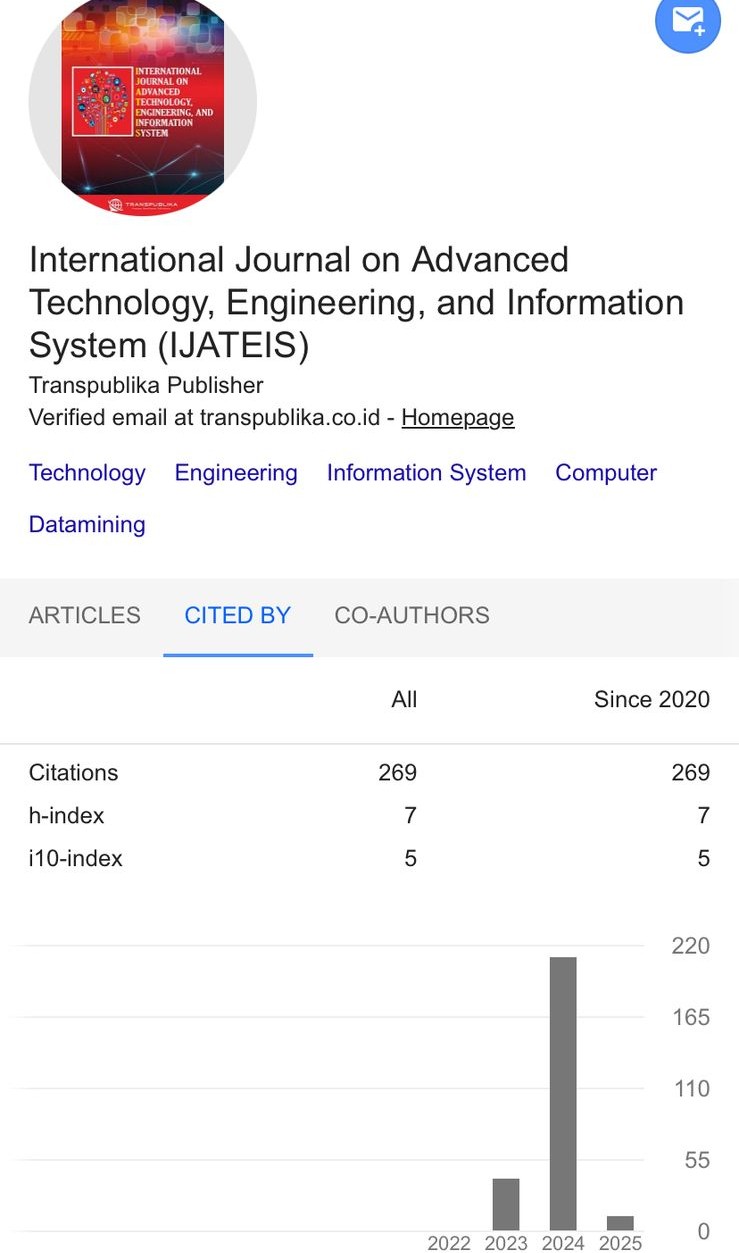The Design of the E-Tracer Medical Record System in the Digital Era to Improve Health Data Management
Main Article Content
Cindy Surya Pramudita*
Falaah Abdussalaam
Irda Sari
The quality of healthcare facilities is greatly influenced by their health data management practices. To keep up with the times and provide better care in this digital era, healthcare organizations must swiftly adopt electronic technology. Creating and implementing a workflow system for electronic medical records is the focus of this article. With the principles of the Xtreme Programming development method, which can enhance health data management, the approach is based on rapid and efficient adjustments as well as continuous improvement. The author identifies that the hospital still relies on manual systems without the E-Tracer application, which could evaluate and identify an objective framework to measure and assess staff performance. This is useful in driving Continuous Quality Improvement (CQI) and other forms of sustainable quality enhancement. As a result, processes that should be running effectively within the data management workflow are instead lagging behind. Consequently, there is a gap between the organization's goals and staff performance, which has not fully met the established operational requirements. The goal of this study is to design and implement the E-Tracer medical record system to enhance health data management in the digital era. The findings suggest that hospitals could benefit from the performance evaluation capabilities of the E-Tracer system in terms of data management and staff performance. The quality of health data management can be measured by reviewing the reports generated by this system over a certain period of time. These reports can help with things like access control and avoiding breaches in medical data.
Abduh, R. (2021). Kajian Hukum Rekam Medis Sebagai Alat Bukti Malapraktik Medis. DE LEGA LATA: Jurnal Ilmu Hukum, 6(1), 221–233.
Adekunle Oyeyemi Adeniyi, Jeremiah Olawumi Arowoogun, Rawlings Chidi, Chioma Anthonia Okolo, & Oloruntoba Babawarun. (2024). The impact of electronic health records on patient care and outcomes: A comprehensive review. World Journal of Advanced Research and Reviews, 21(2), 1446–1455. https://doi.org/10.30574/wjarr.2024.21.2.0592
Alifa Nur Azizah, Azzizah, W. G., Syahidin, Y., & Sari, I. (2023). Tata Kelola Sistem Informasi Rekam Medis Berbasis Elektronik Pada Pelaporan Morbiditas Pasien Rawat Inap. ZONAsi: Jurnal Sistem Informasi, 5(3), 505–514. https://doi.org/10.31849/zn.v5i3.15046
Alomar, D., Almashmoum, M., Eleftheriou, I., Whelan, P., & Anisworth, J. (2024). The Influence of Patient Access to Electronic Health Records on Health Care Engagement: A Systematic Review (Preprint). Journal of Medical Internet Research, 26. https://doi.org/10.2196/56473
Ansori, S., Sari, I., & Sufyana, C. (2022). Sistem Informasi Distribusi Rekam Medis ( Studi Kasus : RSAU Lanud Sulaiman ). Jurnal Sains Dan Informatika, 8(1), 70–79. https://doi.org/10.34128/jsi.v8i1.403
Asriati, Y., Prihandani, R. G., & Pratiwi, J. (2022). Analisis Unsur Manajemen Penyebab Terjadinya Misfile Berkas Rekam Medis Rawat Jalan di Puskesmas Nguter. Indonesian Journal of Health Information Management (IJHIM), 2(2), 1–8.
Choironi, E. A., & Heryawan, L. (2023). Persepsi Dokter Klinik Dalam Menggunakan Rekam Medis Elektronik Berbasis Cloud Computing: Survei Penggunaan rekmed.com. Jurnal Ilmiah Informatika Global, 13(3). https://doi.org/10.36982/jiig.v13i3.2691
Hartawan, P. N., Sudarma, M., & Widyantara. (2021). Extreme Programming for Developing Additional Employee Income System(Case Study: Karangasem Regency Government). International Journal of Engineering and Emerging Technology, 6(2), 117–121.
Lamada, M., Bakry, A., Ifani, A. Z., & Khaerunnisa, K. (2023). Development of Web-Based Project Tender Documents Application Using Extreme Programming Methods. Elinvo (Electronics, Informatics, and Vocational Education), 7(2), 101–111. https://doi.org/10.21831/elinvo.v7i2.49863
Mahdani, R., Yaumi, T., Syahidin, Y., & Yunengsih, Y. (2023). Tata Kelola Rekam Medis Berbasis Elektronik Dalam Pembuatan Laporan Poliklinik Pasien Rawat Jalan Menggunakan Metode Agile. Jurnal Indonesia : Manajemen Informatika Dan Komunikasi, 4(3), 1050–1060. https://doi.org/10.35870/jimik.v4i3.315
Maisa Putra, D., & Alfauzain, A. (2021). Design Of Tracer Using Microsoft Access Unit In Medical Record Primary Health In Padang. International Journal of Engineering, Science and Information Technology, 1(3), 64–74. https://doi.org/10.52088/ijesty.v1i3.90
Meilani, S., & Sari, I. (2021). Perancangan Sistem Informasi Igd Menggunakan Microsoft Visual Studio 2010 Di Rumah Sakit X. Jurnal Indonesia Sosial Teknologi, 2(9), 1650–1659. https://doi.org/10.36418/jist.v2i9.233
Musthofa, N., & Adiguna, M. A. (2022). Perancangan Aplikasi E-Commerce Spare-Part Komputer Berbasis Web Menggunakan CodeIgniter Pada Dhamar Putra Computer Kota Tangerang. OKTAL: Jurnal Ilmu Komputer Dan Sains, 1(03), 199–207.
Naamneh, R., & Bodas, M. (2024). The effect of electronic medical records on medication errors, workload, and medical information availability among qualified nurses in Israel– a cross sectional study. BMC Nursing, 23(1), 1–10. https://doi.org/10.1186/s12912-024-01936-7
Penev, Y. P., Buchanan, T. R., Ruppert, M. M., Liu, M., Shekouhi, R., Guan, Z., Balch, J., Ozrazgat-Baslanti, T., Shickel, B., Loftus, T. J., & Bihorac, A. (2024). Electronic Health Record Data Quality and Performance Assessments: A Scoping Review (Preprint). JMIR Medical Informatics, 12. https://doi.org/10.2196/58130
Permana, Y. R., & Susilo, B. B. B. (2022). Analisa Ketepatan Waktu Pengembalian Dokumen Rekam Medis Rawat Inap Pada Rumah Sakit Umum Daerah Patut Patuh Patju Gerung. Quality Assurance and Health Information Management, 6(2), 51–56.
Permenkes No. 24. (2022). Peraturan Menteri Kesehatan RI No 24 tahun 2022 tentang Rekam Medis. Peraturan Menteri Kesehatan Republik Indonesia Nomor 24 Tahun 2022, 151(2), 1–19.
Permenkes No 18 Tahun 2022. (2022). Permenkes 18. Peraturan Menteri Kesehatan Republik Indonesia Nomor 18 Tahun 2022 Tentang Penyelenggaraan Satu Data Bidang Kesehatan Melalui Sistem Informasi Kesehatan, 848, 1–11.
Setiatin, S., & Abdussalaam, F. (2021). Perancangan Sistem Informasi Peminjaman dan Pengembalian Rekam Medis Rawat Jalan di Rumah Sakit Muhammadiyah Bandung. Jurnal Ilmiah Perekam Dan Informasi Kesehatan Imelda (JIPIKI), 6(2), 139–151.
Supriyatna, A., & Puspitasari, D. (2021). Implementation of Extreme Programming Method in Web Based Digital Report Value Information System Design. IJISTECH (International Journal of Information System & Technology), 5(1), 67. https://doi.org/10.30645/ijistech.v5i1.116
Suryani, K., Rini, M. T., Hardika, B. D., & Widiastari, N. K. (2023). Analisis Faktor Penyebab Kejadian Stunting. Jurnal Keperawatan Florence Nightingale, 6(1), 8–12. https://doi.org/10.52774/jkfn.v6i1.112
Suryanto, H., Munawwarah, A., & Fitriyana, B. A. (2021). Perhitungan Kebutuhan Rak Penyimpanan Dokumen Rekam Medis Dan Luas Ruang Filing Di Rumah Sakit Tahun 2020-2024. Jurnal Rekam Medis Dan Informasi Kesehatan, 4(1), 8–17.
Susilo, B. B. B., Musparlin Halid, & Ikhwan. (2023). Development of Tracer Information System on Medical Record Document. Jurnal Teknologi Informasi Dan Komunikasi, 14(1), 78–85. https://doi.org/10.51903/jtikp.v14i1.477
Tarenta Sari, R., Sari, I., & Abdussalaam, F. (2021). Perancangan Sistem Informasi Rekam Medis Kunjungan Rawat Jalan Menggunakan Microsoft Visual Studio 2010. Cerdika: Jurnal Ilmiah Indonesia, 1(12), 1655–1669. https://doi.org/10.36418/cerdika.v1i12.283
Tasya, A. H., Setiani, T., Syahidin, Y., & Yunengsih, Y. (2023). Tata Kelola Rekam Medis Berbasis Elektronik Dalam Menunjang Pelaporan Operasi Dengan Menggunakan Metode Agile. Jurnal Indonesia : Manajemen Informatika Dan Komunikasi, 4(3), 1265–1273. https://doi.org/10.35870/jimik.v4i3.377
Taufik, F. M. (2022). Perancangan Tracer Pada Bagian Filing Rawat Jalan Untuk Mencegah Terjadinya Missfile Di Rumah Sakit Islam Banjarmasin. STIKES Husada Borneo Banjarbaru.
Tawfik, D., Bayati, M., Liu, J., Nguyen, L., Sinha, A., Kannampallil, T., Shanafelt, T., & Profit, J. (2024). Predicting Primary Care Physician Burnout From Electronic Health Record Use Measures. Mayo Clinic Proceedings, 99(9), 1411–1421. https://doi.org/10.1016/j.mayocp.2024.01.005
Uslu, A., & Stausberg, J. (2021). Value of the Electronic Medical Record for Hospital Care: Update from the Literature. Journal of Medical Internet Research, 23(12). https://doi.org/10.2196/26323
Yada, S., & Aramaki, E. (2023). HeaRT: Health Record Timeliner to visualise patients’ medical history from health record text. ArXiv Preprint ArXiv:2306.14379. https://doi.org/10.48550/arXiv.2306.14379
Yulia, N., Sutiswa, S. I. S., & Herdiana, I. (2021). Edukasi Masyarakat Sehat Sejahtera ( EMaSS ) : Jurnal Pengabdian kepada Masyarakat. Jurnal Pengabdian Kepada Masyarakat, 3(2), 1–4.
Zhang, Y., Cui, M., Zheng, L., Zhang, R., Meng, L., Gao, D., & Zhang, Y. (2019). Research on electronic medical record access control based on blockchain. International Journal of Distributed Sensor Networks, 15(11). https://doi.org/10.1177/1550147719889330












